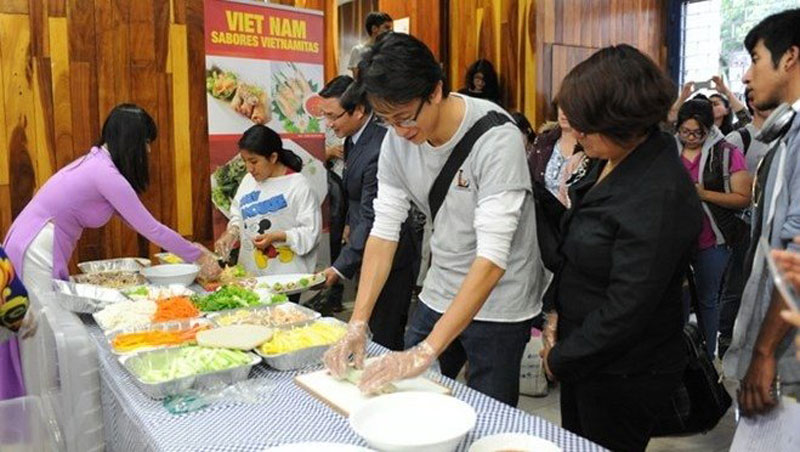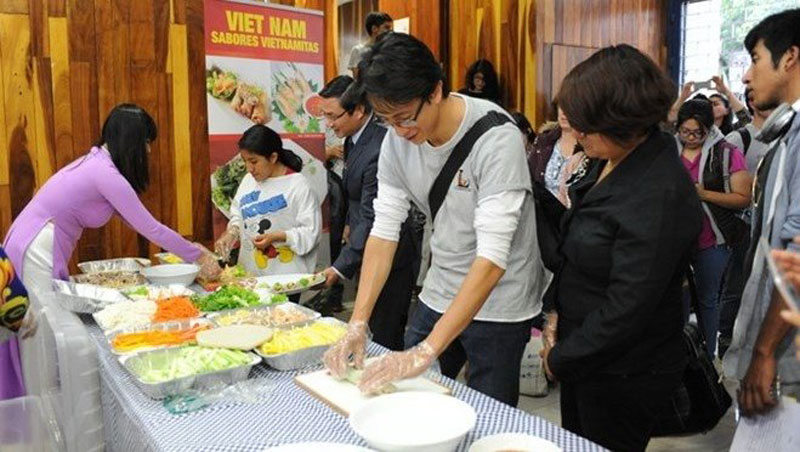
The National School of Languages, Linguistics and Translation under the National Autonomous University of Mexico (UNAM) and the Vietnamese Embassy in Mexico held a Day of Vietnamese Language and Cuisine and screened films to introduce Vietnamese culture to lecturers and students on October 5.

A student is making
Vietnamese spring rolls at the event.
At a Vietnamese-language class, First Secretary of the
Vietnamese Embassy in Mexico Lam Quoc Thanh presented an overview of the
origin, formation and development of the Vietnamese language.
Nearly 50 students learned Vietnam’s alphabet characters,
pronunciation and basic greetings. They expressed wish that more Vietnamese
classes will be opened.
Head of the Russian, Asian and contemporary Greek language
faculty Ricardo Cornejo said the school will consider adding Vietnamese
language into its curricula in the near future to meet students’ demand.
International and Mexican students were also introduced to
Vietnam’s rice paper – a specialty of the wet rice civilization. They learnt
how to make fresh spring rolls using rice papers.
On the occasion, they gained an insight into the unique culture of
H’Mong people, one of the 54 Vietnamese ethnic groups via the film "Story of
Pao” by director Ngo Quang Hai.
Source: NDO
With an increasingly vibrant and widespread emulation movement aimed at building cultured residential areas and cultured families, Yen Thuy District has been making steady progress toward improving both the material and spiritual well-being of its people, while fostering a civilized, prosperous, beautiful, and progressive community.
Once lacking recreational spaces and community facilities, Residential Group 2 in Quynh Lam Ward (Hoa Binh City) has recently received attention for the construction of a new, spacious, and fully equipped cultural house. The project followed the model of state support combined with public contributions in both labor and funding.
The "All people unite to build cultural life" movement, which has been effectively integrated with Kim Boi district’s socio-economic development goals, is fostering a lively spirit of emulation across local residential areas, hamlets, villages, public agencies, and enterprises. In addition, through the initiative, traditional cultural values are being preserved and promoted, while community solidarity and mutual support in poverty reduction and economic development are being strengthened.
A working delegation of the Hoa Binh provincial People’s Committee led by its Permanent Vice Chairman Nguyen Van Toan on June 11 inspected the progress of a project to build the Mo Muong Cultural Heritage Conservation Space linked to tourism services in Hop Phong commune, Cao Phong district.
Born and growing in the heroic land of Muong Dong, Dinh Thi Kieu Dung, a resident in Bo town of Kim Boi district, in her childhood was nurtured by the sweet lullabies of her grandmother and mother. These melodies deeply imprinted on her soul, becoming an inseparable part of her love for her ethnic group's culture. For over 20 years, this love for her hometown has driven Dung to research, collect, and pass down the cultural values of the Muong people to future generations.
In the final days of May, the Ethnic Art Troupe of Hoa Binh Province organized performances to serve the people in remote, mountainous, and particularly disadvantaged areas within the province. These were not just ordinary artistic shows, but they were the meaningful journeys aimed at spreading cultural values, enhancing the spiritual life of the people and contributing to the preservation of ethnic minority cultural identities.



